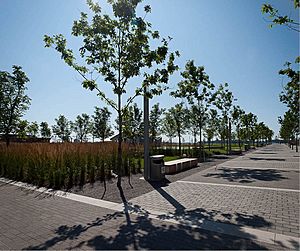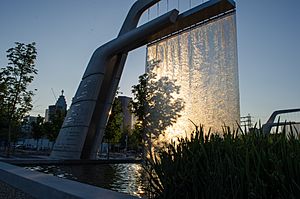Sherbourne Common facts for kids
Quick facts for kids Sherbourne Common |
|
|---|---|
 |
|
| Location | 61 Dockside Drive, Toronto, Ontario |
| Area | 1.47 hectares (3.63 acres) |
| Established | [July 23, 2009] |
| Operated by | Toronto Parks |
| Website | Sherbourne Common |
Sherbourne Common is a unique waterfront park located in Toronto, Ontario, Canada. It was designed by landscape architect Phillips Farevaag Smallenberg. This park is special because it's one of the first in Canada to include a system that cleans rainwater from the nearby area right into its design!
The park is about 1.47 hectares (which is like 3.6 acres) and stretches across two city blocks. It goes all the way from Lake Ontario north to Lake Shore Boulevard.
Discovering Sherbourne Common's Features
Sherbourne Common was a project by Waterfront Toronto. It features a long water channel, about 240 meters long. Along this channel, you'll see three amazing art sculptures called "Light Showers." These sculptures are nine meters tall and were created by artist Jill Anholt. They were made using strong fiberglass molds filled with a special type of concrete.
The park is also home to many trees, with 182 planted in total. You can find 108 Pacific Sunset Maple trees, 45 Red Oak trees, and 29 American Beech trees.
How the Park Cleans Water
The clever system that cleans rainwater is located in the basement of the park's Pavilion building. This building was designed by Teeple Architects Inc. The plant takes rainwater, cleans it, and then sends the purified water back into the park. It flows out through the three "Light Showers" art installations, making them part of the water cleaning process!
Sherbourne Common's Green Efforts
This Toronto park is a great example of how we can protect our environment. It uses smart ways to save water in its landscaping. Also, the Pavilion building meets Toronto's Green Building Requirements and follows the Leadership in Energy and Environmental Design standards. This means it was built using environmentally friendly methods and materials.
The stormwater treatment facility inside the Pavilion uses clean, renewable energy sources to power its operations. After the water is cleaned, it's pushed through the tall concrete art sculptures and into the park's man-made canal. Any extra clean water then flows into Lake Ontario, helping to keep the lake healthy.
The park also makes it easy for people to be green by offering bicycle storage and easy access to public transportation.


